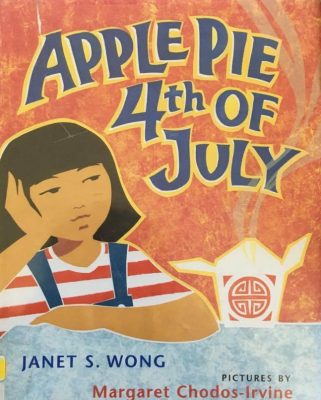
Author: Janet S. Wong
Illustrator: Margaret Chodos-Irvine
Publisher and Year: HMH for Young Readers, 2006
Number of pages: 40
Tags: K-1, 2-3, 4-5 Fiction, Diversity, Culture, Family, Amy Sanchez
Analysis: This book is about a young Chinese-American girl. Her parents own a small neighborhood store that sells Chinese food. This girl, laments the fact that her their business is open every day except Christmas. It is the fourth of July and the young girl can hear the 4th of July parade down the street, yet her family is cooking Chinese food. The little girl says she smells apple pie from the neighbors upstairs, but in their kitchen, she smells chow mein. She believes that Chinese food is just not the kind of food one eats on Independence Day. The little girl seems a bit restless and annoyed throughout the day and customers come in and buy simple things like and potato chips, while her family focuses on tradition. She claims that no one wants Chinese food on the fourth of July and that her parents do not understand all American things, since they were not born in this country. In the evening, the store starts filling up with people who are in the mood for Chinese food. The girl realizes that being American means so much more than she thought. Although it was not stated, it appears the little girl understands that cultures can merge.
This book can serve as window to understand what it is like to straddle two cultures. This book portrayed the difficulties of a young girl understanding and embracing her culture as well as being patriotic. This story is one that illustrates how America is diverse and that we all have our own traditions. This book can also serve as a mirror for multicultural children who are learning to embrace their cultural identity. As previously mentioned, the book portrays the struggle of a young Chinese-American girl who is trying to straddle two cultures. This book can also be a door to teach children about different practices or traditions that people hold. Our country has so many cultures with different traditions, and no one tradition is better or the right one to practice even on the fourth of July.
The ideology this book explores is the idea that there is no one way to be American. There is a buildup of frustration throughout the book. As the little girl expresses her discontent toward her family for making chinse food on the 4th of July. However, the girl is pleasantly surprised when all the “Americans” begin coming into the store in search of Chinese food. This teaches the main character that there are many ways to celebrate the 4th of July.
The illustrations used in this book use an open frame, so our view is from the outside. The illustrations are bold. They help illustrate both cultures. For many of the pages, the little girl is positioned on the left side, meaning she is more secure. For some of the illustrations the young girl is facing away or facing down. Those illustrations help portray her frustration. They help convey those emotions. The images are adding to the words by showing the little girl facing away as she is expressing her frustration with her parents. The illustrations help capture the emotions the little girl is experiencing.
